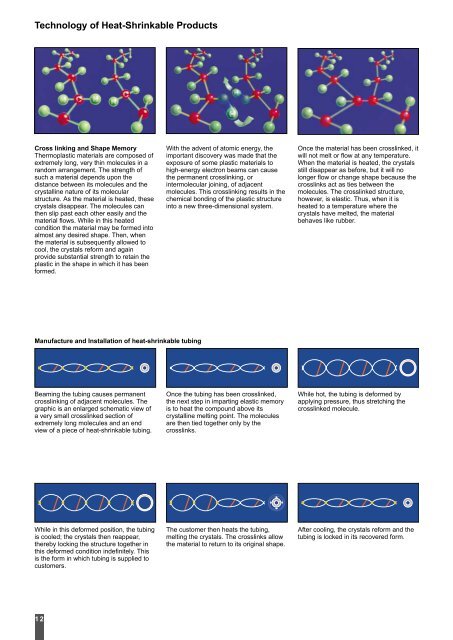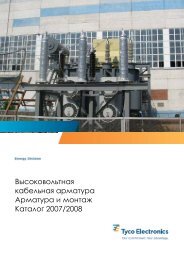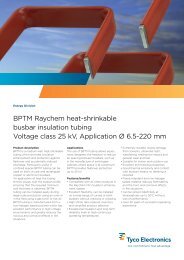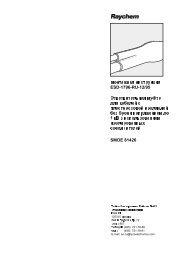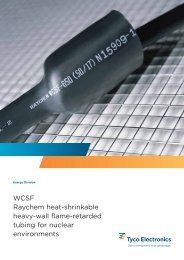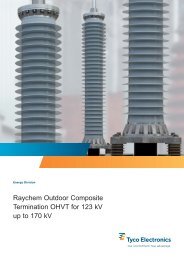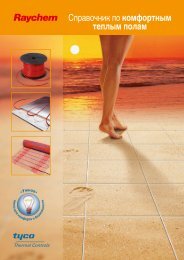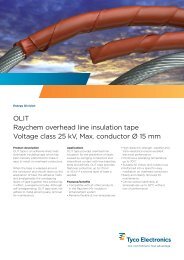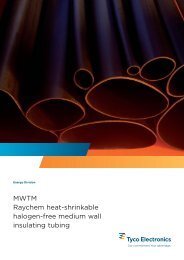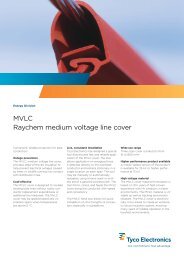Power Cable Accessories
Power Cable Accessories
Power Cable Accessories
Create successful ePaper yourself
Turn your PDF publications into a flip-book with our unique Google optimized e-Paper software.
Technology of Heat-Shrinkable Products<br />
Cross linking and Shape Memory<br />
Thermoplastic materials are composed of<br />
extremely long, very thin molecules in a<br />
random arrangement. The strength of<br />
such a material depends upon the<br />
distance between its molecules and the<br />
crystalline nature of its molecular<br />
structure. As the material is heated, these<br />
crystals disappear. The molecules can<br />
then slip past each other easily and the<br />
material flows. While in this heated<br />
condition the material may be formed into<br />
almost any desired shape. Then, when<br />
the material is subsequently allowed to<br />
cool, the crystals reform and again<br />
provide substantial strength to retain the<br />
plastic in the shape in which it has been<br />
formed.<br />
Manufacture and Installation of heat-shrinkable tubing<br />
Beaming the tubing causes permanent<br />
crosslinking of adjacent molecules. The<br />
graphic is an enlarged schematic view of<br />
a very small crosslinked section of<br />
extremely long molecules and an end<br />
view of a piece of heat-shrinkable tubing.<br />
While in this deformed position, the tubing<br />
is cooled; the crystals then reappear,<br />
thereby locking the structure together in<br />
this deformed condition indefinitely. This<br />
is the form in which tubing is supplied to<br />
customers.<br />
1 2<br />
With the advent of atomic energy, the<br />
important discovery was made that the<br />
exposure of some plastic materials to<br />
high-energy electron beams can cause<br />
the permanent crosslinking, or<br />
intermolecular joining, of adjacent<br />
molecules. This crosslinking results in the<br />
chemical bonding of the plastic structure<br />
into a new three-dimensional system.<br />
Once the tubing has been crosslinked,<br />
the next step in imparting elastic memory<br />
is to heat the compound above its<br />
crystalline melting point. The molecules<br />
are then tied together only by the<br />
crosslinks.<br />
The customer then heats the tubing,<br />
melting the crystals. The crosslinks allow<br />
the material to return to its original shape.<br />
Once the material has been crosslinked, it<br />
will not melt or flow at any temperature.<br />
When the material is heated, the crystals<br />
still disappear as before, but it will no<br />
longer flow or change shape because the<br />
crosslinks act as ties between the<br />
molecules. The crosslinked structure,<br />
however, is elastic. Thus, when it is<br />
heated to a temperature where the<br />
crystals have melted, the material<br />
behaves like rubber.<br />
While hot, the tubing is deformed by<br />
applying pressure, thus stretching the<br />
crosslinked molecule.<br />
After cooling, the crystals reform and the<br />
tubing is locked in its recovered form.


